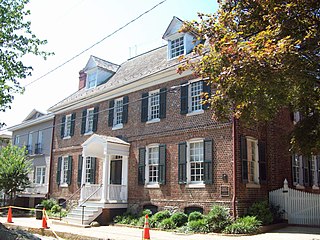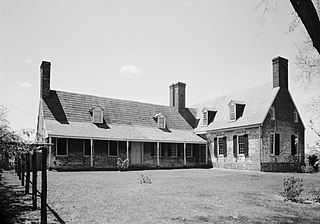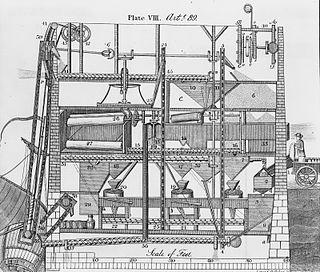
Doughoregan Manor is a plantation house and estate located on Manor Lane west of Ellicott City, Maryland, United States. Established in the early 18th century as the seat of Maryland's prominent Carroll family, it was home to Founding Father Charles Carroll, a signer of the United States Declaration of Independence, during the late 18th century. A portion of the estate, including the main house, was designated a National Historic Landmark on November 11, 1971. It remains in the Carroll family and is not open to the public.

The Peggy Stewart House, also known as the Rutland-Jenifer-Stone House, is a Georgian style house in Annapolis, Maryland. Built between 1761 and 1764 by Thomas Rutland as a rental property, it was owned at various times by Thomas Stone and U.S. Founding Father Daniel of St. Thomas Jenifer. In October 1774 it was owned by Anthony Stewart, owner of the ship Peggy Stewart. It was listed in the National Register of Historic Places in 1973 for its associations with the burning of Anthony Stewart's ship, Peggy Stewart, as well as for its architectural significance as a mid- to late 18th century Georgian mansion. Furthermore, the dwelling was recognized as a National Historic Landmark for its associations with Jenifer and Stone, and for the thematic representation of politics and diplomacy during the American Revolution

Schifferstadt, Also known as Scheifferstadt, is the oldest standing house in Frederick, Maryland. Built in 1758, it is one of the nation's finest examples of German-Georgian colonial architecture. It was designated a National Historic Landmark in 2016.

The Curtis—Shipley Farmstead is a historic home located at Ellicott City, Howard County, Maryland, United States. It is located on the first land grant in modern Howard County, then Anne Arundel County, to the English settler Adam Shipley in 1688 who settled properties in Maryland as early as 1675. The 500-acre estate was called "Adam the First".

White Hall is a historic home located at Ellicott City, Howard County, Maryland, United States. It consists of three sections: the east wing, dating from the early 19th century, the center section, and the west wing. In 1890 the house was partially destroyed by fire and rebuilt in 1900. Three outbuildings remain on the White Hall property: a small square frame workshop; a smokehouse-privy; and springhouse.

Maidstone is an old southern Maryland plantation located in Owings, Calvert County, Maryland. The oldest extant part of the house was built in 1751 by a yeoman planter, Lewis Lewin on or near the site of an earlier wood structure., though a brick in one of the chimneys is dated 1678.

The Abington Farm, or Abbington Manor & Farm, is a historic home and stables at Crownsville, Anne Arundel County, Maryland, United States. The main house is a 2+1⁄2-story frame, side-passage, double-pile house with additions on both gable ends. The main block dates from about 1840. On the property are several outbuildings, including a frame summer kitchen; a stone and frame ice house; a frame, brick, and stone springhouse/dairy; a frame privy, chicken house, tool shed, and corncrib; a large, elaborate frame stable; and a frame tenant house.

Burrages End is a historic home near Lothian, Anne Arundel County, Maryland, United States. It is a small 1+1⁄2-story frame house with gambrel roof. The site is noteworthy for containing a number of buildings from the late 18th century or early 19th century. The house was constructed c. 1780, replacing an earlier house on the site, according to a 1982 study by the Architectural Research Department of the Colonial Williamsburg Foundation, presumably by Col. John Weems who purchased the property in 1764. Weems was the construction contractor for the 1762-65 St. James' Church 3/4 mile to the south. At Weems' death in 1794, Burrages End was sold to Thomas Sellman and remained in that family's hands until 1946. A Weems-Sellman cemetery is on site.

Portland Manor is a historic home at Lothian, Anne Arundel County, Maryland, United States. It is a 2-story, center-passage plan, frame building. The main block was constructed in 1754, with the two wings added and enlarged about 1852. Also on the property are the remains of a large circular ice house and several frame outbuildings. Portland Manor was listed on the National Register of Historic Places in 1996.

Richland is a historic home at Harwood, Anne Arundel County, Maryland. It is a 2+1⁄2-story, frame, hip-roofed dwelling of approximately 3,000 square feet (280 m2). It was constructed for gentleman farmer Robert Murray Cheston (1849–1904) and his wife, the former Mary Murray (1859–1943). It is the only known late-19th-century rural Anne Arundel County dwelling definitively associated with a specific architectural firm. The plans were prepared by the Roanoke, Virginia based architectural firm of Noland and de Saussure, founded by William C. Noland. The home reflects both the Colonial Revival and Queen Anne styles. The house on the 332 acre Richland farm was built in 1893. In the 1950s, the Cheston family subdivided the property and sold the house with approximately 58 acres to the Talliaferro family, and sold the remaining acreage to the Catterton family. The Talliaferro family named their new parcel "Thanksgiving Farm". In 1996, the Heimbuch family purchased Thanksgiving Farm from the Talliaferro family, began planting vineyards1998, completed a restoration of the house in 2004, and opened a winery on the property in 2006.

Rosehill is a historic home and property at Gambrills, Anne Arundel County, Maryland. The property consists of 17 acres (69,000 m2) of partially wooded and cleared land on which are located a dwelling and six outbuildings. The dwelling displays a complex construction evolution originating from a mid-18th-century frame, 1+1⁄2-story double-pile plan house with an unusual short side passage. This is believed to be the first documented example of this form in the Chesapeake Bay region. The six outbuildings include an early-19th-century frame corn house, a documented 1821 frame tobacco barn, a log outbuilding, a late-19th-century stable, and a late-19th- or early-20th-century pumphouse. The Hopkins family owned the property for 173 years, from 1799 until 1972.

Holly Hill, also known as Holland's Hills or Rose Valley, is a historic house at Friendship, Anne Arundel County, Maryland, United States. It was initially named as Holland's Hills for Francis Holland, who bought the land in 1665. Richard Harrison, a Quaker planter and shipowner, bought the land and built a home on it. Harrison owned about 6,000 acres total.
James Owens Farm is a historic home and farm at Bristol, Anne Arundel County, Maryland. The home was built by successful tobacco farmer James Owens and is a large mid-19th century, two-story brick cross-gable late Greek Revival/Italianate dwelling. Outbuildings are all of frame construction and include an early 19th-century cornhouse, an early 19th-century tobacco barn, a mid-19th-century board-and-batten kitchen, carriage house, and smokehouse, and a late 19th-century chicken house.

All Hallows Church, also known as The Brick Church, is a historic church located at 3604 Solomon's Island Road, in Edgewater, Anne Arundel County, Maryland, United States. Parish records date back to 1682, indicating that it existed prior to the Act of Establishment (1692) passed by the General Assembly of Maryland laying off the Province into 30 Anglican parishes.

Hilton is a historic home located at The Community College of Baltimore County in Catonsville, Baltimore County, Maryland. It is an early-20th-century Georgian Revival–style mansion created from a stone farmhouse built about 1825, overlooking the Patapsco River valley. The reconstruction was designed by Baltimore architect Edward L. Palmer, Jr. in 1917. The main house is five bays in length, two and a half stories above a high ground floor, with a gambrel roof. The house has a 2+1⁄2-story wing, five bays in length, with a gabled roof, extending from the east end; and a two-story, one-bay west wing. The roof is covered with Vermont slate. The house features a small enclosed porch of the Tuscan order that was probably originally considered a porte cochere.

Round About Hills or Peacefields is a historic slave plantation home located at Glenwood, Howard County, Maryland. An alternate address for this house is 14581 McClintock Drive, Glenwood, Maryland. It was built about 1773 on a 266-acre land patent and consists of a 1+1⁄2-story frame house with a stone end. Thomas Beale Dorsey inherited the property in 1794 then exchanged his interest in the plantation with Thomas Cook's stagecoach wayside town Cooksville.

Gilfillan Farm is located at the junction of Washington and Orr roads in Upper St. Clair Township, Allegheny County, Pennsylvania, United States. It is a working farm whose current form dates to the mid-19th century.

The Clagett House at Cool Spring Manor is a historic house in Prince George's County, Maryland, built around 1830 by William Digges Clagett on the family's Cool Spring Manor property. Constructed in a style more typical of the Deep South, it is a hip roofed wood frame dwelling standing on a brick foundation.

Roxbury Mill is a historic flour and grist mill located in Glenwood, Howard County, Maryland, now part of the Howard County Farm Museum.

Athol is a historic slave manor and rectory located in Columbia (Simpsonville), Howard County, Maryland, U.S.

























